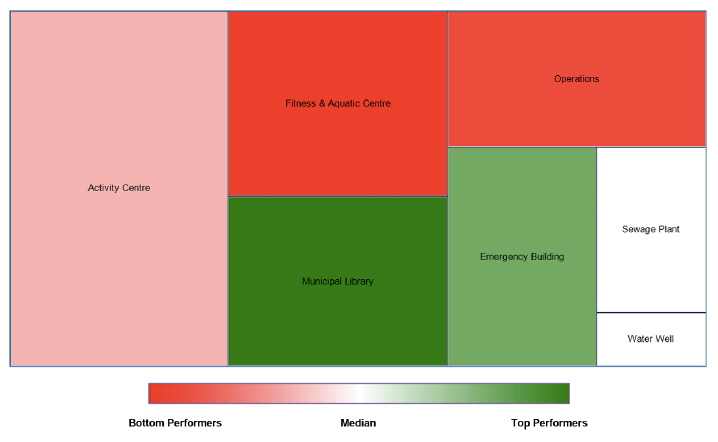Scott Hayes, Local Journalism Initiative Reporter | [email protected]
The festive colours in the above chart represent, in order, the municipality’s worst and best performing buildings in terms of electrical and natural gas usage.
The Jasper Fitness and Aquatic Centre is shown in red while the Library and Cultural Centre is firmly in the green.
The information used is according to the Energy Benchmark Report that was presented to the municipal council last week by energy manager, Faraz Khan, who surveyed the seven buildings and determined their energy usage and efficiency level, along with their output of greenhouse gases.
The report uses 2019 figures as a baseline as the last two years have been skewed due to COVID-19.
The energy benchmarking report compares the municipality’s building energy performance against regional and national databases, and that comparison will be used to help the municipality identify those facilities that have the greatest opportunity to reduce energy usage and therefore increase cost savings.
The report starts by observing three metrics of energy consumption and energy expenditure in comparison to other similar buildings in the same climate zone.
While both Jasper’s annual energy use divided by the total square meters of its buildings and its annual energy cost (both figures divided by the total square meters of its buildings) are mostly on par with the median levels of comparators, its annual energy cost divided by the average number of occupants shows where the municipality veers away from its maximal efficiency of $1,394 per occupant as compared to $792 per occupant for the median.
The report is a first step toward identifying which facilities the municipality should focus on and develop reduction targets.
Some facilities – such as Jasper Fitness and Aquatic Centre – are larger but also have a greater attendance, while others – such as the Jasper Municipal Library and Cultural Centre – are relatively smaller and might not see the same high attendance figures.
“This study… is just to get a high-level understanding of the usages. We may need to take some assumptions and averages into consideration. Unless it's recorded accurately, it's hard to tell how many people visit on a daily basis. That's the challenge there, so we need to balance that out,” Khan said.
“Right now, it's a good way to look at it and say, ‘Hey, it seems like it's on the higher side… maybe we need to look at heating and cooling. Is the building under or over capacity? Or is there heating happening overnight when there's nobody in the building? Is there heating and cooling happening at the same time?’ (Questions such as these) help you identify those things by looking at that metric. It helps us to start digging into those sorts of questions.”
The library building is also LEED certified, making it an already high-efficiency facility. LEED refers to Leadership in Energy and Environmental Design, a widely used green building rating system that provides a framework for healthy, highly efficient, and cost-saving buildings.
The library building naturally uses less electricity and natural gas, whereas the activity centre is the highest user of energy in the municipality.
The activity centre has a correlated higher level of greenhouse gas emissions, measuring at 1,273 metric tons of carbon dioxide, which is equal to about 34.1 per cent of the municipality’s total annual emissions of 3,729 metric tons (roughly 8,425 barrels of oil.)
Khan said that there really weren’t any big surprises in the Energy Benchmark Report.
“I think it's what we expected to see. We expected the bigger facilities like the activity and fitness centres to be the major contributors,” he said, pointing out that the emergency services building, and the library building are both performing well.
“It's good to also see that there's an opportunity to reduce costs and energy consumption in other buildings as well (as) it helps us target which building (to focus on). We don't want to spend a whole lot of time looking at the municipal library because we know it's already doing its best in similar types of buildings (so) we can actually focus our time and attention on the ones that have the biggest opportunities of energy efficiency and energy reduction.”




